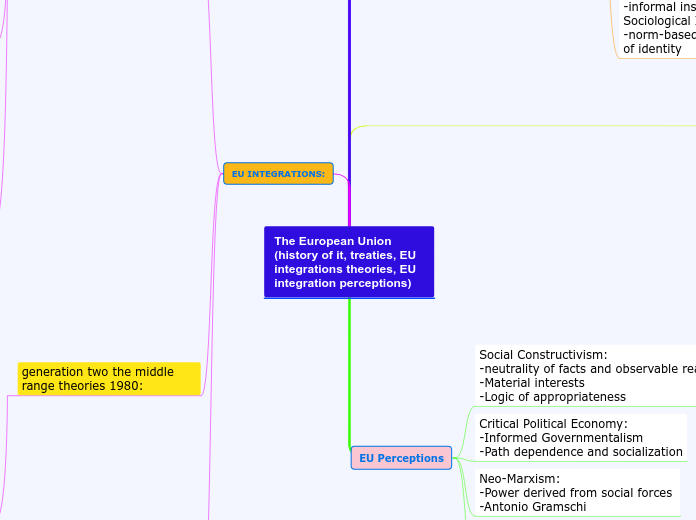The European Union (history of it, treaties, EU integrations theories, EU integration perceptions)
EU INTEGRATIONS:
generation three of EU theory 1960-1980-1990:
The grand theory of 1960 outlines the EU's integration and mechanism.
-1980-1990 middle range methods, mosaic of "EIT" explains and analyzes the EU integration results,
-generation 3, from 1990 to today, they researched EU democracy and the EU as a polity, as well as the institutionalism debate.
generation two the middle range theories 1980:
It was concerned with the outcome of the EU's integration (functioning).
This explains how the integration process progressed.
-policy analysis: looking at how policy is made, the policy period, and networks operate, as well as using methodological methods.
-New institutionalism: (institution matter) the basic understanding of how institutions affect EU government, as well as versions of new institutionalism like: - (Historical, rational choice, sociological)
generation one: neofunctionalism and intergovernmentalism:
Neofunctionalism has the following characteristics: -state concepts are more complex; -interest groups and bureaucratic agents' operations are not limited to the domestic political sphere.
Non-state players have a significant role in foreign politics.
-European integration arose as a result of spillover.
-working peace concept is the theoretical background of neofunctionalism.
-It is not a European integration ideology.
-It is incompatible with the European federalist definition.
Neofunctionalism recognizes the logical inadequacy of institutions as well as the need for practical, technologically relevant institutions to carry out the activities of the state.
Generation one: neofunctionalism and intergovernmentalism, with the response "integrate to integrate further" for "neofunctionalism" (they began small projects with the goal of integrating more).
The aim of intergovernmentalism was to maximize the utility and profits of individual states.
EU'S treaties:
1987:SEA
1993: Maastricht. ON EU
1967: brussels treaty, unified EU institutions.
1952: pairs treaty ECSC.
1958: Rome treaty ECC.
1993: A'DAM, high representative+ ESDP.
2003: NICE COPING WITH ENLARGMENT.
2009: Lisbon (EC+EU=EU)
history of EU
2004, 2007, 2013
Ten new EU representatives entered in 2007, including Bulgaria and Romania, and Croatia in 2013.
2002
Copenhagen commits to a major expansion of the EU to include ten additional nations.
1998
Enlargement begins with structured agreements.
1992
defining the requirements for membership of the EU, such as independence, democracy, a functioning market system, and the capacity to enforce EU laws
1989
the collapse of communism and the fall of the Berlin Wall
Rome treaty 1958
The European Economic Community (EEC) and the European Atomic Energy Agency (EURATOM) were created.
1950,54
The European Defence Community (EDC) was established in 1954, and the World Economic Union (WEU) was founded in 1955.
Paris treaty 1952
The first move was to create the EU by forming the ECSC.
EU Perceptions
New Regionalism:
-EU as sui generis
-deviant case of regional integration
Neo-Marxism:
-Power derived from social forces
-Antonio Gramschi
Critical Political Economy:
-Informed Governmentalism
-Path dependence and socialization
Social Constructivism:
-neutrality of facts and observable realities
-Material interests
-Logic of appropriateness
Main topic
EU Theories:
-Neofunctionalism
-Intergovernmentalism
-Liberal Intergovernmentalism
-Postfunctionalism
-court of justice-court of auditors.
-economic social committee.
-committee of the regions.
-European investment bank.
-agencies.
-European central bank.
Rational Choice Institutionalism:
-utility-based, logic of consequences
Historical Institutionalism:
-perception matters not abstract rationality
-informal institutions
Sociological Institutionalism:
-norm-based, logic of appropriateness, internalisation of identity
Postfunctionalism:
-Permissive consens to constraining dissens
-Strong public opinion
-Politicization
Liberal Intergovernmentalism:
-Bottom-up approach
-National preference formation
-Intergovernmental strategic bargaining
Neoliberalism:
-Economic interdependence
-Reaction to neorealism
-Complex (transnational) interdependence
-Less dependent on the issue area
Intergovernmentalism
-Maximizing utility
-rational considerations
-Co-operative decision making
structure of EP:
-conference of presidents
president, 14 vice presidents
-leaders of political groups.
-plenary session: once(month,76,MEPs,strasbourg)
-permanent committees: technical, legislature work
Subtopic
note: EPS organize themselves into a political group, that include representatives from different EU countries based on their political affinities. according to the parliament law, a political group must be composed of at least 25 Members. and they can only join to 1 political group. if a member won't join a group are then so-called non-attached member. but currently 7 members fulfill the criteria to sahpe a group.
Neofunctionalism:
-pragmatic necessity of institutions
-unintentional consequences
-non-state actors are important

